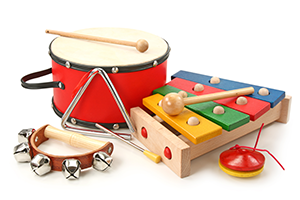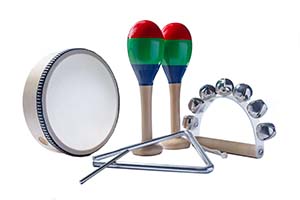Prep. Lesson 11. Different sounds
Prior learning: None
Duration: 30 minutes
Materials: Tuned and non-tuned percussion, snail puppet
Keywords: Beat, singing, chanting, partners, rhymes, circle games
Difficulty: ![]()
 Melodic development
Melodic development
![]() Students revisit this classic song by singing and clapping to the rhythm for embedded learning.
Students revisit this classic song by singing and clapping to the rhythm for embedded learning.

- Have a snail puppet as a prop to assist in teaching this song, as well as introducing a winding game.
- In this activity, students hold hands while you guide the class in winding around repeatedly to form a snail shell as everyone sings the song while keeping the beat in their feet.
- Instruct students not to move until the snail gently taps their head.
- As you unwind the shell and pass by each student, softly touch their head and direct them to follow the leader.
 Listening
Listening
![]() Students identify different sounds from percussion instruments and establish their materials.
Students identify different sounds from percussion instruments and establish their materials.
- Have a xylophone, glockenspiel, woodblock and triangle on the desk.
- Sing and clap the rhythm of Big Black Train.
- Play the rhythm of Big Black Train on the triangle. Ask students what kind of sound they are hearing. Wooden? Metallic?
- Then ask if anyone can identify the song just from the rhythm.
- Now use the woodblock and repeat the questions.
- Now play the xylophone - use the same melody. Ask what kind of sound they are hearing.
- Repeat the process with the glockenspiel.
- Finally, ask the class which instruments have a metal sound and a wooden sound. Which do they prefer?
 Rhythmic development
Rhythmic development
![]() Students identify different types of voices by copying a teacher-led rhyme and fingerplay.
Students identify different types of voices by copying a teacher-led rhyme and fingerplay.
Lyrics
Two fat gentlemen
Met in a lane
Bowed most politely
And bowed once again
"How do you do?"
"How do you do?"
"How do you do?" once again.
Two thin ladies, etc.
Two tall policemen, etc.
Two naughty schoolboys, etc.
Two little babies, etc.
- Showcase the rhyme with a well-paced tempo to enhance engagement.
- This captivating rhyme is an ideal resource for incorporating finger play into your lessons, encouraging the development of fine motor skills and coordination development.
- Start by having the students follow the beat of the rhyme, echoing the words after you. This process helps improve their listening skills, memory, and rhythmic awareness.
- Introduce different vocal tones during the activity, from deep and resonant to soft and childlike. This will make the experience more enjoyable and emphasise the importance of diverse voice qualities in communication and self-expression.
- This rhyme activity is vital in fostering an implicit understanding of timbre among young learners. By recognizing the unique characteristics of various vocal tones, students develop a deeper appreciation for the nuances of sound and communication, laying the groundwork for more advanced musical and linguistic understanding.

 Activities
Activities
![]() Students explore and identify the differences in sounds from instruments and various objects.
Students explore and identify the differences in sounds from instruments and various objects.
How sounds are made
- Using a guitar, ukulele, or similar plucked instrument, pluck a note. Explain to students that some sounds are made by plucking a string on an instrument.
- Using a shaker, cabasa or similar, demonstrate how sounds are made by shaking.
- Using a hand drum, show how sounds are made by hitting the drum with a stick. Then use your hand. Ask students if they can hear the difference in sound.
- If you have access to a violin or similar bowed instrument, then demonstrate how sounds are made by bowing.
Balloon sounds!
- Inflate a balloon in front of the class.
- Ask students how many sounds can be made by a balloon.
- The class explores the different sounds a balloon can make when air is in (banging it) and when let out, such as squeaking, fizzing, squealing and popping!
- This game can be great fun but be careful!
Box of sound
- Fill several small bags, hidden from view but accessible, with materials such as rice, feathers, popcorn kernels, paper clips, small plastic balls, coins etc.
- Empty the contents of the first bag into a small box. Explain: "This is my box of sound. I put different things inside, and when I shake it, it makes different sounds. You get to guess what's inside. Let's try it out."
- Use the following chant to play Box of Sound: "Box of sound, Box of sound, Shake it around. What have we found?".
- The class will try to establish the box's contents and the sound it makes. Is the sound metallic, rubbery, soft, etc?
 Visual learning
Visual learning
![]() Students identify and recognise different percussion instruments, whether wood or metal.
Students identify and recognise different percussion instruments, whether wood or metal.
 Farewell
Farewell
![]() Reinforces students' pitch ability through listening, imitation, and repetition. 'Good morning' or 'Bee, Bee, Bumblebee' are good examples.
Reinforces students' pitch ability through listening, imitation, and repetition. 'Good morning' or 'Bee, Bee, Bumblebee' are good examples.
Suggested lessons
Prep. Lesson 12. Louder and softer sounds II
Students learn that sounds can be louder or softer. AC9AMUD01
Prep. Lesson. 13. Longer and shorter sounds
 Students learn that sounds can be longer or shorter. AC9AMUD0
Students learn that sounds can be longer or shorter. AC9AMUD0
Prep. Lesson 14. Faster and slower sounds
 Students learn that sounds can be faster or slower. AC9AMUD01
Students learn that sounds can be faster or slower. AC9AMUD01

